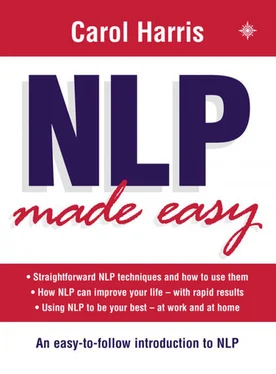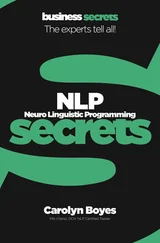If what you are doing isn’t working, do something else
Flexibility is a key to effectiveness; if you vary what you do until you get a result, you are more likely to be effective than if you continue to carry out behaviour which is not getting you to where you want to be.
You do the best you can at the time
Although, with hindsight, many things could be done differently, we can only make the best choice at the time. This does not mean that we always make the ‘right’ decision; simply that decisions are based on ‘best guesses’ at the time. (‘New code’ NLP might take a different view of this and help us listen more to our ‘body signals’, but more of that in Chapter 3.)
Every behaviour has a positive intent
Even the most negative-seeming behaviour is done for a purpose. This is a useful assumption to make when dealing with others, as it enables you to consider why they behave as they do, to explore their real needs and, possibly, to find alternative ways of meeting them.
The meaning of the communication is the response you get
It is the perception of the receiver that determines the effectiveness of interaction, not the intention of the initiator.
Almost all the presuppositions have been debated at length, for example the proposal that all behaviour has a positive intent, or the fact that what is possible for one person is potentially possible for all. However, the point of the presuppositions is to enable people to extend themselves and to perceive opportunities and benefits in situations. By acting as if the presuppositions were true, it is amazing what can be achieved.
Where did NLP come from? Many of the ideas used in NLP originated in much earlier times. Certainly many of the concepts were known about decades ago and some were mentioned, although in very different terminology, centuries ago. There are, however, a number of specific connections between NLP and other established disciplines, in particular the following:
 Applied psychology:It is easy to think of NLP as a branch of applied psychology. To label it in this way is really to diminish its impact, as it goes beyond the bounds of traditional psychology, but it is probably a good initial way of considering it. One explanation of how NLP goes beyond conventional psychology is as follows: ‘While traditional clinical psychology is primarily concerned with describing difficulties, categorizing them, and searching for historical causes, NLP is interested in how our thoughts, actions, and feelings work together right now to produce our experience.’ (Faulkner) There is also a link with psychometric testing (and some Jungian ‘traits’) in the use of one of the NLP language patterns called Meta-Programmes (see Chapter 5) .
Applied psychology:It is easy to think of NLP as a branch of applied psychology. To label it in this way is really to diminish its impact, as it goes beyond the bounds of traditional psychology, but it is probably a good initial way of considering it. One explanation of how NLP goes beyond conventional psychology is as follows: ‘While traditional clinical psychology is primarily concerned with describing difficulties, categorizing them, and searching for historical causes, NLP is interested in how our thoughts, actions, and feelings work together right now to produce our experience.’ (Faulkner) There is also a link with psychometric testing (and some Jungian ‘traits’) in the use of one of the NLP language patterns called Meta-Programmes (see Chapter 5) .
 Gestalt psychology/psychotherapy:One of the early role models for NLP was Fritz Perls, the reputed father of Gestalt psychotherapy. Gestalt relates to the linkages between elements, so that an entity can be understood through the interrelationships of its parts; the parts alone do not necessarily make sense. (One area of NLP deals with ‘parts’ and that will be covered in more detail in Chapter 3.)
Gestalt psychology/psychotherapy:One of the early role models for NLP was Fritz Perls, the reputed father of Gestalt psychotherapy. Gestalt relates to the linkages between elements, so that an entity can be understood through the interrelationships of its parts; the parts alone do not necessarily make sense. (One area of NLP deals with ‘parts’ and that will be covered in more detail in Chapter 3.)
 Ericksonian hypnosis:Another early role model was Milton Erickson and his influence on NLP has been enormous. Unlike classical hypnosis, the Ericksonian approach is seemingly low key and unobtrusive. Much use is made of indirect language, suggestion and utilization of the patient/client/subject’s own patterns of speaking, breathing and moving in order to bring about change. Erickson himself was expert at adapting his approach to the specific needs of the individual with whom he was working and this way of working has informed many of NLP’s later practitioners (although the indirect approach is closely linked with Erickson, he was substantially influenced by classical hypnosis and did use a lot of direct techniques himself).
Ericksonian hypnosis:Another early role model was Milton Erickson and his influence on NLP has been enormous. Unlike classical hypnosis, the Ericksonian approach is seemingly low key and unobtrusive. Much use is made of indirect language, suggestion and utilization of the patient/client/subject’s own patterns of speaking, breathing and moving in order to bring about change. Erickson himself was expert at adapting his approach to the specific needs of the individual with whom he was working and this way of working has informed many of NLP’s later practitioners (although the indirect approach is closely linked with Erickson, he was substantially influenced by classical hypnosis and did use a lot of direct techniques himself).
Systems thinking/cybernetics:Much of NLP utilizes systems thinking. Work by Ashby, Beer and others has had a major impact on how NLP has developed and been used and many of the NLP models presented in Chapter 3explore the systemic nature of different areas of experience.
 Linguistics:Much of NLP originated in the work of linguists, including Korzybski and Chomsky. Such people had laid down many of the principles which underlie NLP’s language patterns. Some of the connections which have been made are with the ways in which language represents experience, especially in a metaphorical sense, and the ways in which language demonstrates people’s underlying motivational and Behavioural patterns.
Linguistics:Much of NLP originated in the work of linguists, including Korzybski and Chomsky. Such people had laid down many of the principles which underlie NLP’s language patterns. Some of the connections which have been made are with the ways in which language represents experience, especially in a metaphorical sense, and the ways in which language demonstrates people’s underlying motivational and Behavioural patterns.
In addition, some topics that are becoming associated with NLP are:
 Accelerated learning:Accelerated learning puts much emphasis on the needs of the individual and the helpfulness of recognizing and utilizing individual patterns in order to enhance learning and development. The earliest writer on this topic was the Bulgarian Georgi Lozanov, working in the 1960s, and other famous names in the field are Ostrander, Schroeder and Jenson, who have written at length about how to improve trainer/trainee relationships. In particular, accelerated learning puts the onus on the trainer to ensure that the learner is in a resourceful state in which to learn, and this means that learning is not simply a one-way process of pushing information towards a recipient and hoping it will stick, but involves creating an atmosphere and an environment in which interaction and mutual respect can lead to individual growth.
Accelerated learning:Accelerated learning puts much emphasis on the needs of the individual and the helpfulness of recognizing and utilizing individual patterns in order to enhance learning and development. The earliest writer on this topic was the Bulgarian Georgi Lozanov, working in the 1960s, and other famous names in the field are Ostrander, Schroeder and Jenson, who have written at length about how to improve trainer/trainee relationships. In particular, accelerated learning puts the onus on the trainer to ensure that the learner is in a resourceful state in which to learn, and this means that learning is not simply a one-way process of pushing information towards a recipient and hoping it will stick, but involves creating an atmosphere and an environment in which interaction and mutual respect can lead to individual growth.
 Bodywork:NLP is increasingly being associated with the field of physical development as well as psychological enhancement. Some examples of current links are the Alexander Technique, Feldenkrais, kinesiology, tai chi, voicework/singing, and so forth. With all of these techniques, practitioners use a mixture of body movement and mental/emotional control to achieve results.
Bodywork:NLP is increasingly being associated with the field of physical development as well as psychological enhancement. Some examples of current links are the Alexander Technique, Feldenkrais, kinesiology, tai chi, voicework/singing, and so forth. With all of these techniques, practitioners use a mixture of body movement and mental/emotional control to achieve results.
NLP constantly draws upon other disciplines and approaches to integrate appropriate parts of them with its own ways of working. Because of this, NLP is evolving all the time and, while it remains recognizable, is fluid and flexible.
Having explained what NLP is, it is also important to mention what NLP is not. There are several popular misconceptions about NLP and the following questions are often asked by people new to NLP:
Isn’t NLP just positive thinking?
Well, yes, in a way, but it goes far beyond simply having nice thoughts and actually gives people a way of knowing what to do in order to think positively. For example, some years ago a training video was produced on presentation skills. The video told viewers that it was important, when making a presentation, to feel confident . However, no advice was offered on how to do that! NLP makes it possible to offer such advice by being able to identify specific things that can be done to master thoughts and feelings as well as behaviour.
Читать дальше

 Applied psychology:It is easy to think of NLP as a branch of applied psychology. To label it in this way is really to diminish its impact, as it goes beyond the bounds of traditional psychology, but it is probably a good initial way of considering it. One explanation of how NLP goes beyond conventional psychology is as follows: ‘While traditional clinical psychology is primarily concerned with describing difficulties, categorizing them, and searching for historical causes, NLP is interested in how our thoughts, actions, and feelings work together right now to produce our experience.’ (Faulkner) There is also a link with psychometric testing (and some Jungian ‘traits’) in the use of one of the NLP language patterns called Meta-Programmes (see Chapter 5) .
Applied psychology:It is easy to think of NLP as a branch of applied psychology. To label it in this way is really to diminish its impact, as it goes beyond the bounds of traditional psychology, but it is probably a good initial way of considering it. One explanation of how NLP goes beyond conventional psychology is as follows: ‘While traditional clinical psychology is primarily concerned with describing difficulties, categorizing them, and searching for historical causes, NLP is interested in how our thoughts, actions, and feelings work together right now to produce our experience.’ (Faulkner) There is also a link with psychometric testing (and some Jungian ‘traits’) in the use of one of the NLP language patterns called Meta-Programmes (see Chapter 5) .










